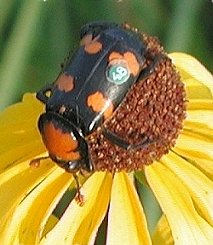Burying beetle
| Burying beetle | |
|---|---|
 |
|
| American burying beetle (Nicrophorus americanus) | |
| Scientific classification | |
| Kingdom: | Animalia |
| Phylum: | Arthropoda |
| Class: | Insecta |
| Order: | Coleoptera |
| Family: | Silphidae |
| Subfamily: | Nicrophorinae |
| Tribe: | Nicrophorini |
| Genus: |
Nicrophorus Fabricius, 1775 |
| Type species | |
|
Silpha vespillo Linnaeus, 1758 |
|
Burying beetles or sexton beetles (genus Nicrophorus) are the best-known members of the family Silphidae (carrion beetles). Most of these beetles are black with red markings on the elytra (forewings). Burying beetles are true to their name—they bury the carcasses of small vertebrates such as birds and rodents as a food source for their larvae. They are unusual among insects in that both the male and female parents take care of the brood.They are carnivores.
The genus name is sometimes spelled Necrophorus in older texts. This is an emendation by Carl Peter Thunberg (1789) of Fabricius's original name, and is not valid.
The American burying beetle (sp. Nicrophorus americanus) has been on the U.S. endangered species list since 1989.
Burying beetles have large club-like antennae equipped with chemoreceptors capable of detecting a dead animal from a long distance. After finding a carcass (most usually that of a small bird or a mouse), beetles fight amongst themselves (males fighting males, females fighting females) until the winning pair (usually the largest) remains. If a lone beetle finds a carcass, it can continue alone and await a partner. Single males attract mates by releasing a pheromone from the tip of their abdomens. Females can raise a brood alone, fertilizing her eggs using sperm stored from previous copulations. The carcass must be buried by the beetle(s) to get it out of the way of potential competitors, which are numerous.
The prospective parents begin to dig a hole below the carcass. While doing so, and after removing all hair from the carcass, the beetles cover the animal with antibacterial and antifungal oral and anal secretions, slowing the decay of the carcass and preventing the smell of rotting flesh from attracting competition. The carcass is formed into a ball and the fur or feathers stripped away and used to line and reinforce the crypt, where the carcass will remain until the flesh has been completely consumed. The burial process can take around 8 hours. Several pairs of beetles may cooperate to bury large carcasses and then raise their broods communally.
...
Wikipedia
